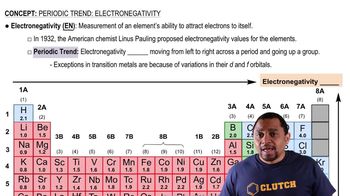Which of the following statements about the bonding atomic radii in Figure 7.7 is incorrect? (i) For a given period, the radii of the representative elements generally decrease from left to right across a period. (ii) The radii of the representative elements for the n = 3 period are all larger than those of the corresponding elements in the n = 2 period. (iii) For most of the representative elements, the change in radius from the n = 2 to the n = 3 period is greater than the change in radius from n = 3 to n = 4. (iv) The radii of the transition elements generally increase moving from left to right within a period. (v) The large radii of the Group 1 elements are due to their relatively small effective nuclear charges.
Ch.7 - Periodic Properties of the Elements
Chapter 7, Problem 25c
Using only the periodic table, arrange each set of atoms in order from largest to smallest: (c) F, O, N.

Verified Solution
Video duration:
3mWas this helpful?
Key Concepts
Here are the essential concepts you must grasp in order to answer the question correctly.
Atomic Radius
The atomic radius is a measure of the size of an atom, typically defined as the distance from the nucleus to the outermost electron shell. Atomic radius generally decreases across a period from left to right due to increased nuclear charge, which pulls electrons closer to the nucleus. Conversely, it increases down a group as additional electron shells are added, resulting in larger atomic sizes.
Recommended video:
Guided course

Atomic Radius
Periodic Trends
Periodic trends refer to the predictable patterns observed in the properties of elements as you move across or down the periodic table. Key trends include atomic radius, ionization energy, and electronegativity. Understanding these trends helps in predicting the behavior of elements, such as their size, reactivity, and bonding characteristics.
Recommended video:
Guided course

Periodic Trends
Electronegativity
Electronegativity is a measure of an atom's ability to attract and hold onto electrons in a chemical bond. While it primarily influences bonding behavior, it is also related to atomic size; smaller atoms with higher electronegativity tend to have stronger attractions for electrons. This concept is important for understanding how elements interact and form compounds.
Recommended video:
Guided course

Electronegativity Trends
Related Practice
Textbook Question
1124
views
Textbook Question
Estimate the As¬I bond length from the data in Figure 7.7 and compare your value to the experimental As ¬I bond length in arsenic triiodide, AsI3, 2.55 Å.
589
views
Textbook Question
The experimental Pb¬Cl bond length in lead(II)chloride,
PbCl2, is 244 pm. Based on this value and data in Figure 7.7,
predict the atomic radius of Pb.
955
views
Textbook Question
Using only the periodic table, arrange each set of atoms in order of increasing radius: (b) S, Si, Sr
515
views
Textbook Question
Identify each statement as true or false: (a) Cations are larger than their corresponding neutral atoms.
540
views
Textbook Question
Identify each statement as true or false: (b) Li+ is smaller than Li.
371
views
